Reimagining the infrastructure of cancer care

Transforming possibilities into results
Featured products & solutions
Clinicians, researchers, and regulators rely on FLATIRON HEALTH® technology and evidence to learn faster and power smarter care for every patient.
Achieve your oncology real-world evidence goals faster and more efficiently
Generate robust evidence and insights by partnering with Flatiron's expert team of clinicians, scientists, and health data analysts.
See how— Hear from our customers
Fit-for-purpose RWE solutions
Flatiron was chosen because it’s fit for purpose. You have the right population and good sample size with data for the endpoint, which is overall response rate. A key learning is you need to choose a database with good quality.
— By the numbers
5 million+
5 million+ patient records de-identified and available for research
Discover a faster, more efficient path to clean study data
One of the industry's first EHR-to-EDC connectors, Flatiron Clinical Pipe™ helps create a new trial experience.
See how— Hear from our customers
Transfer trial data faster
Working with partners like Flatiron and technology like [Flatiron] Clinical Pipe and Flatiron Vessel has been an excellent opportunity for us to really build processes and systems around the technology that is available today and get those technologies to work together.
— By the numbers
85 sites and counting
Flatiron Clinical Pipe™ is live at 85 sites and counting
Unleash precision oncology with our customizable clinical decision support platform
Improve the patient experience, streamline operations, and increase revenue with instinctive workflows, up-to-date treatment guidelines, and actionable data.
See how— Hear from our customers
Expand insights at the point of care
Flatiron Assist is a decision support tool that helps us choose and find the right regimens for our patients, stay within NCCN guidelines, and the treatment plans are very robust and customizable.
— By the numbers
44% reduction
44% reduction in the number of unique regimens ordered across cancer centers using Flatiron Assist™
Solving problems for teams across the oncology ecosystem
How we partner
Transforming cancer care takes all of us. Our vision is to build a world where technology and science close the gap between care and research.
Academic Medical Centers
Enable quality care by providing evidence-based treatment options to clinicians and run more efficient clinical research by surfacing trial-eligible patients directly in the EHR. Once enrolled, digitally transfer relevant trial data from the EHR to downstream systems.
HEOR & RWE Teams
Design and execute real-world studies including comparative effectiveness, modeling long-term survival, and analyzing treatment patterns to provide insights into a treatment's long-term effectiveness as well as support market access and reimbursement decisions.
Research & Early Development Teams
Quicken drug discovery and development by linking genomics data with clinical outcomes to help assess unmet need, generate hypotheses about biomarker resistance alterations and co-alterations, and inform decision-making.
how we partner
Clinical Operations Teams
Accelerate clinical research timelines, increase trial participant representativeness, and execute trials more efficiently to get your treatment to market sooner.
Regulatory Affairs Teams
Leverage Flatiron's extensive experience with regulatory-grade real-world data to develop regulatory strategies, prepare evidence packages for approval and post-market requirements, and lead regulatory engagement.
how we partner
Community Oncology Practices
Deliver quality patient care with a cancer-specific EHR and surface evidence-based treatment options. For practices that support research, save time and gain accuracy through data-backed identification of eligible trial patients in the EHR and digitally transfer relevant study data seamlessly between the EHR and EDC.
Market Access Teams
Demonstrate a cancer drug's value to payers and Health Technology Assessment (HTA) bodies to accelerate access to life-extending cancer treatments worldwide and ensure reimbursement and optimal pricing.
how we partner
Pharmacovigilance & Epidemiology Teams
Monitor and assess the safety of cancer drugs, leveraging retrospective and prospective real-world studies to identify adverse events, detect safety signals, and provide insights into the long-term safety profile of cancer drugs beyond clinical trials.
how we partner
Contract Research Organizations
Optimize clinical trials with our novel, interoperable technology. Flatiron's products provide CROs with a streamlined, technology-driven approach to accelerate trial timelines, make data-backed decisions, and create efficiencies, giving you more confidence in trial success.
Clinical Development Teams
Utilize deep real-world data to assess the impact of inclusion/exclusion criteria and enable adjustments based on diversity goals and enrollment timelines through tailored protocol analyses that include insights on patient characteristics and expected outcomes.
Portfolio Strategy and Commercial Teams
Generate fast insights to identify portfolio gaps and opportunities, refine your commercial strategy and provide real-time line of sight into the launch performance and uptake with tailored RWE solutions.
how we partner
Medical Affairs Teams
Leverage Flatiron's RWE solutions to generate insights for the scientific community, regulatory agencies, healthcare professionals, and the broader market to ensure that new drugs are developed, communicated, and utilized effectively and ethically.



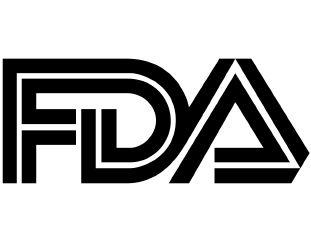

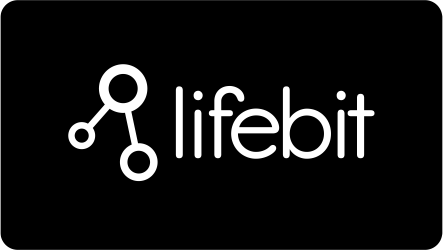
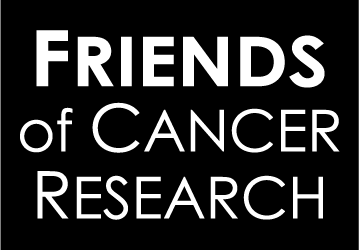
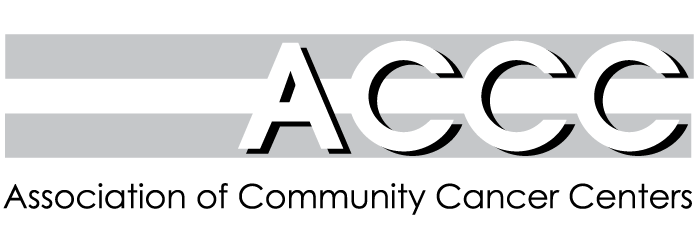


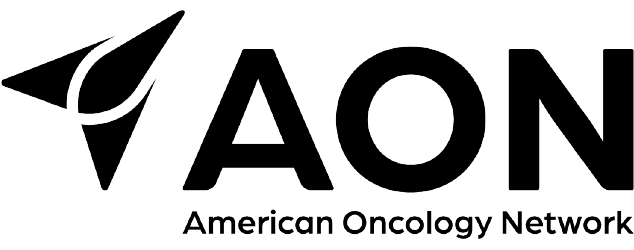













New and noteworthy
featured news and insights
Explore the latest insights, research, and stories from Flatiron’s global team.
- Read more
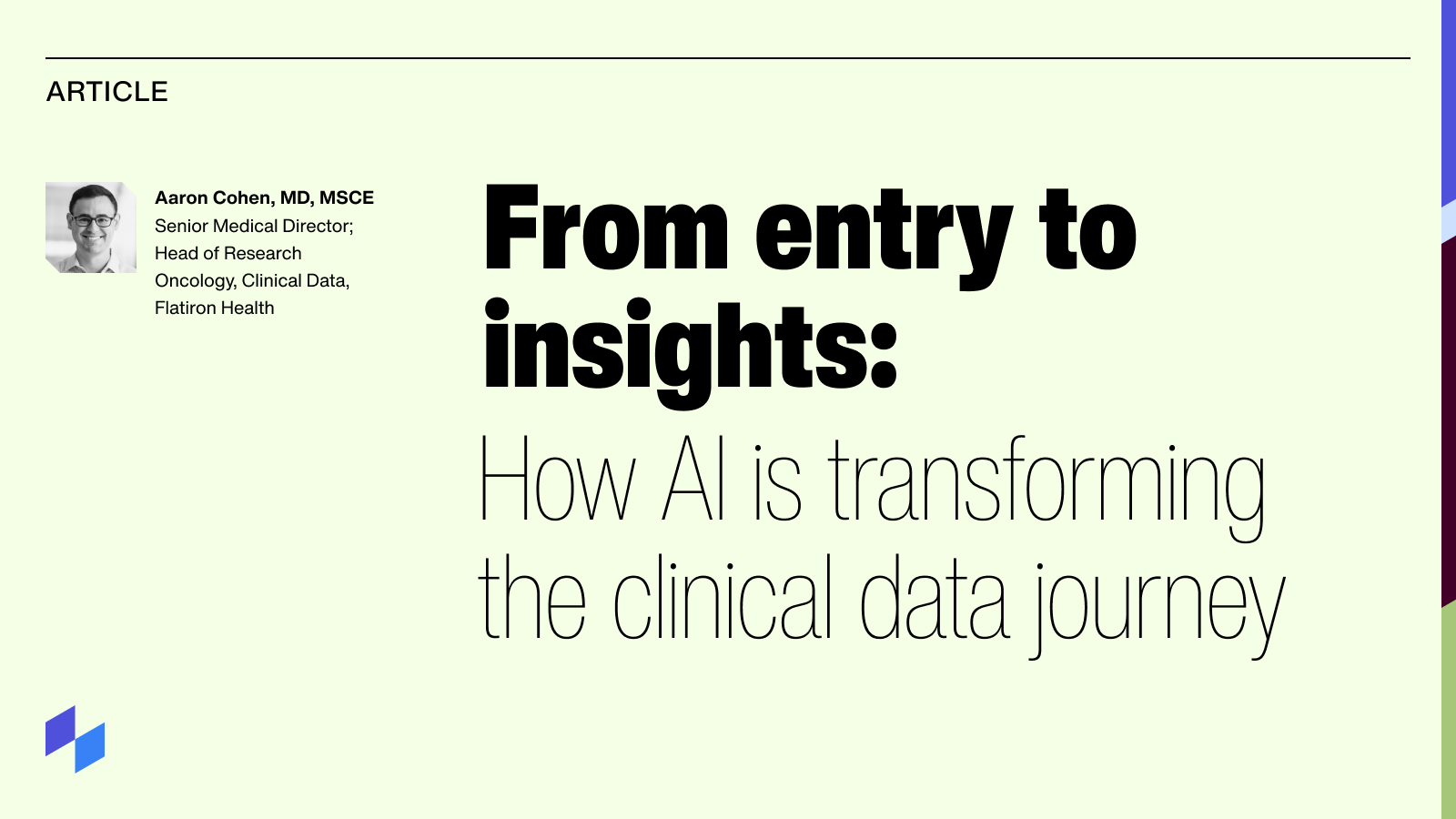
From entry to insights: How AI is transforming the clinical data journey
As a medical oncologist working at both Bellevue Hospital and Flatiron Health, I see firsthand how the details I document in patient charts—like the date of a cancer diagnosis or the results of genomic testing—are more than just notes for immediate care or billing. These details hold the potential to shape research, guide treatment decisions, and help connect patients with clinical trials that could change their lives. As advancements in artificial intelligence (AI) continue at a breakneck pace, one of the things I'm most excited about (apart from AI writing my patient notes!) is the ability of large language models (LLMs) to make sense of the complex clinical information buried in medical charts and pull out the critical details that can help enable these promising applications. For example, a patient with stage 4 lung cancer might be a candidate for a clinical trial based on a specific gene mutation, but if that result is tucked away in a scanned PDF or long visit note, it may not be surfaced in time for their oncologist to act. In a fast-moving field like oncology, where trial slots are limited and treatment windows are narrow, a delay in finding this information can mean the difference between accessing a cutting-edge therapy or missing the opportunity altogether. At Flatiron, we’ve pioneered the use of LLMs to extract clinically meaningful information from the EHR, making de-identified patient data more accessible and actionable. The ultimate goal? To ensure every person’s experience can help inform and improve outcomes for people with cancer. The enthusiasm around using LLMs for EHR data curation is well deserved—these models are transforming how we identify and utilize clinical insights at scale. AI and machine learning (ML) have the power to process vast amounts of patient data rapidly and extract meaningful insights from hundreds of pages of documents. As a result, we can more nimbly understand evolving standards of care and the efficacy of new treatments in real time. But what often goes unnoticed is the meticulous, behind-the-scenes work required to ensure LLMs are producing critical data points that are not only scalable but also accurate, complete, and helpful. Let’s take a closer look at how a single piece of clinical data travels from a clinician’s keyboard to become key evidence advancing research and informing patient care.
- Read more
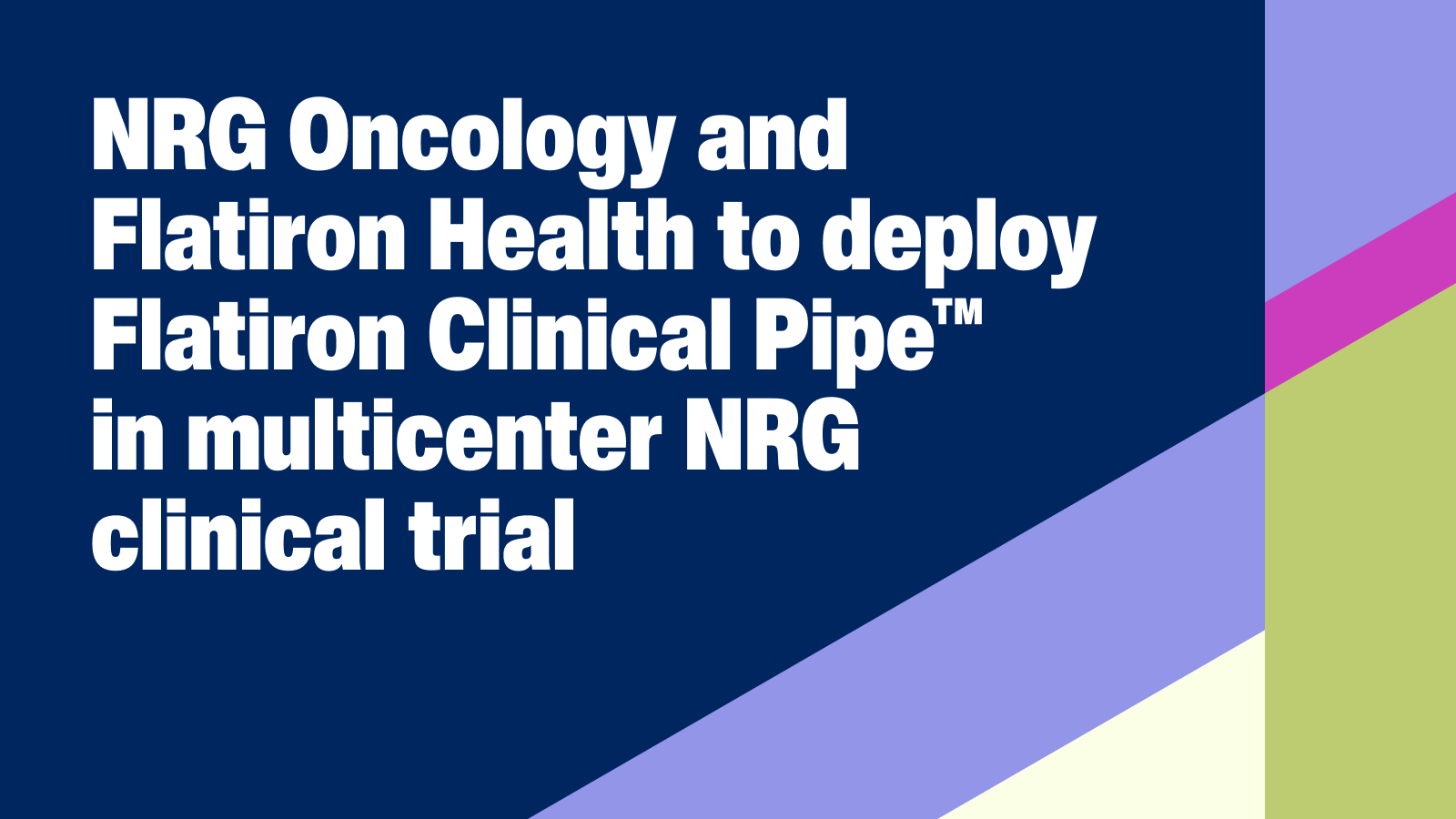
NRG Oncology and Flatiron Health announce collaboration to leverage leading technology to drive more efficient clinical trials
Flatiron Health, a healthtech company transforming clinical research through technology that integrates research into everyday care, today announced a collaboration with NRG Oncology (NRG), a clinical research consortium in the National Cancer Institute (NCI)’s National Clinical Trials Network (NCTN) comprised of over 1,300 worldwide research sites, to deploy Flatiron Clinical Pipe™ in a multicenter NRG clinical trial. Flatiron Clinical Pipe™, a cutting-edge electronic health record (EHR) to electronic data capture (EDC) connector, improves efficiency and reduces time and effort of clinical study data entry. This collaboration broadens Flatiron Clinical Pipe™ use cases to include NCTN sponsored studies—applying Flatiron’s EHR-to-EDC technology to reduce the burden on NRG clinical trial site teams, streamline data management, and accelerate study timelines. In parallel, NRG and Flatiron will conduct a correlative study to assess the efficiency of Flatiron Clinical Pipe™ use compared to traditional data entry methods. “Collaborating with NRG Oncology, a leading research consortium within the National Clinical Trials Network, is an incredible opportunity to create a new trial experience—unlocking higher data quality and more efficient data acquisition with Flatiron Clinical Pipe,” said Alex Deyle, General Manager of Clinical Research at Flatiron Health. “By putting our cutting-edge technology in the hands of more research teams, Flatiron and NRG will enhance our ongoing efforts to improve efficiency and reduce time and effort of study data capture, ultimately accelerating evidence generation and improvements in care for people with cancer.” Research published in the journal ESMO Real World Data and Digital Oncology, found that teams using Flatiron Clinical Pipe™ were able to accurately transfer thousands of data points, representing completion of hundreds of case report form (CRF), with the average time of 37 seconds for a user to launch, complete, and submit a CRF, representing significant time savings for data entry over the course of a trial.1 Reducing the amount of time spent on administrative tasks to drive more efficient clinical trials enables providers to spend more meaningful time with patients, improving the care experience for all involved. “We are very excited about the rich potential of this collaboration with our partners at Flatiron, a leader in healthcare systems technology. Enhancing clinical trial efficiency with Clinical Pipe, and other emerging technologies, holds the promise of delivering NRG clinical trial results to our patients with greater accuracy and speed, helping us deliver on the promise of less suffering from cancer through operational advances.” Alexandra Thomas MD, FACP, Vice Chair NRG Protocol Operation Management For more information, visit https://flatiron.com/clinical-research-solutions/clinical-pipe/
- Read more
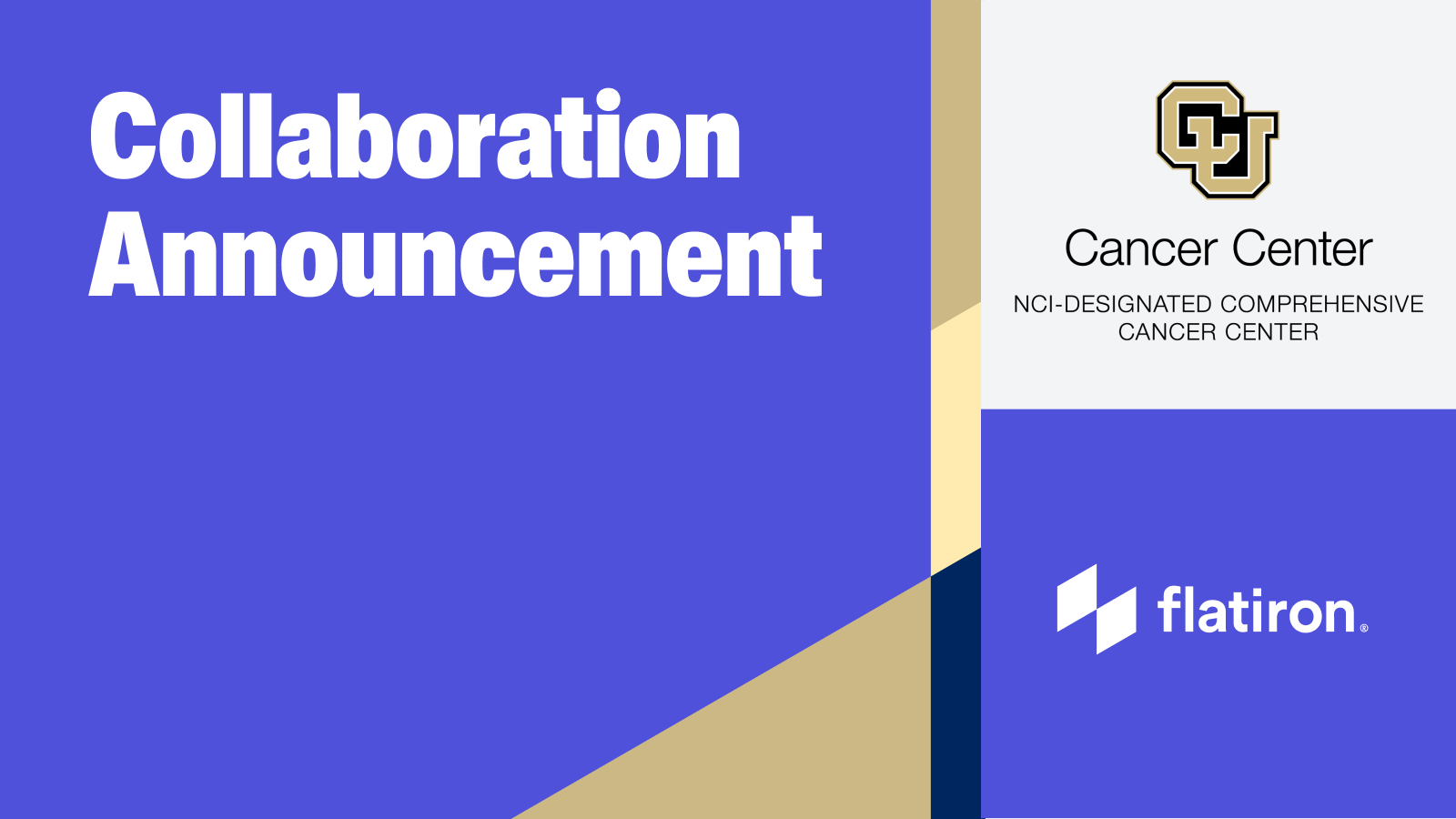
The University of Colorado Cancer Center and Flatiron Health announce collaboration to drive more efficient clinical trials
Flatiron Health, a healthtech company transforming clinical research through technology that integrates research into everyday care, today announced a collaboration to enable Flatiron Clinical Pipe™ at the University of Colorado Cancer Center (CU Cancer Center) and their clinical care partner UCHealth. Flatiron Clinical Pipe™, a cutting-edge electronic health record (EHR) to electronic data capture (EDC) connector, improves efficiency and reduces time and effort of clinical study data capture.
- Read more

How scaled real-world evidence insights advance breast cancer research
Breast cancer treatment and research have evolved dramatically over the last few decades with the discovery of novel biomarkers, the development and approval of new therapies, and a deeper understanding of the disease itself.While it is an exciting time for breast cancer research and clinical practice, the rate at which the field is evolving poses challenges for clinicians who are trying to adapt their practice to a rapidly changing landscape as well for those in drug development.In this article, we’ll discuss how real-world evidence (RWE) can answer questions that inform drug discovery, development and clinical practice. We’ll share three case studies that illustrate the role that RWE can play in advancing breast cancer research and providing answers to many lingering questions about the future of cancer care.